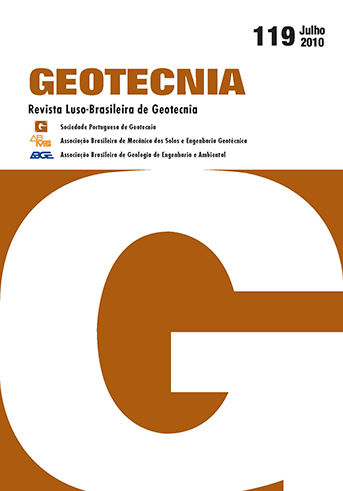Empirical model to determine hydraulic conductivity using grain-size data
DOI:
https://doi.org/10.14195/2184-8394_119_3Keywords:
Hydraulic conductivity, Grain-size curves, Rio Claro formation, Empirical modelsAbstract
A great number of models have been proposed for estimating hydraulic conductivity as a func tion of grain size distribution of soil/sediment. However these relationships are applicable to specific sample attributes. The present work demonstrates the use of multiple regression analysis to define empirical rela tionship between grain size and hydraulic conductivity (as determined from slug test) of unconsolidated sedi ments of a lithologically heterogeneous aquifer. The sediments located in an industrial area of Paulínia (SP) are correlated to Rio Claro Formation (Cenozoic). The excellent correlation is confirmed by a determination coefficient of 0.98. These results show that indirect hydraulic characterization of sediments is possible using multiple regression method for estimating hydraulic conductivity values in the studied area.
Downloads
References
ALYAMANI, M. S.; SEN, Z. (1993). Determination of Hydraulic Conductivity from Complete Grain-Size Distribution Curves. Ground Water. Vol. 31, n. 16, pp. 551-555.
ASSOCIAÇÃO BRASILEIRA DE NORMAS TECNICAS (1984). NBR 7181 - Solo: Análise granulométrica. Rio de Janeiro.
BLUTER, J. J. Jr. (1996). Slug tests in site characterization: Some Practical Considerations. En vironmental Geosciences, v.3, n. 3.
CARMAN, P. C. (1937). Fluid Flow through Granular Beds. Trans. Inst. Chem. Eng., v. 15, n. 150.
CARMAN, P. C. (1956). Flow of Gases through Porous Media. Butterworths. Scientific Publica tions, London, 1.
DAVIS, J. C. (1973). Statistics and Data Analysis in Geology. John Wiley and Sons.
FERNANDES, A. J. (1997). Tectônica cenozóica na porção media da bacia do Rio Piracicaba e sua aplicação a hidrogeologia de meios fraturados. Instituto de Geociências, Universidade de São Paulo, Sao Paulo, Tese de Doutoramento, 244 p.
FETTER, C. W. (1994). Applied Hydrogeology. New York : Macmillan Publishing Company, 3º ed., 314 p.
HAZEN, A. (1892). Some physical properties of sands and gravels, with special reference to their use in filtration. 24th Annual Rep., Massachusetts State Board of Health, Pub. Doc. No. 34, pp. 539-556.
KOZENY, J. (1927). Ueber kapillare Leitung des Wassers im Boden.Wien, Akad. Wiss., v. 136, n. 2a, p. 271.
PEDE, M. A. Z. (2004). Caracterização da condutividade hidráulica do embasamento cristalino alterado saturado na região metropolitana de São Paulo. 95 p. Dissertação (Mestrado em Geo ciências) - Instituto de Geociências e Ciências Exatas, Universidade Estadual Paulista, Rio Claro.
SHEPHERD, R. G. (1989). Correlations of Permeability and Grain Size. Groundwater, v. 5, n. 27, pp. 633-638.
TERZAGHI, K.; PECK, R. B. (1964). Soil Mechanics in Engineering Practice. Wiley, New York.
VUKOVIC, M.; SORO, A. (1992). Determination of Hydraulic Conductivity of Porous Media from Grain-Size Composition. Water Resources Publications, Littleton, Colorado.




